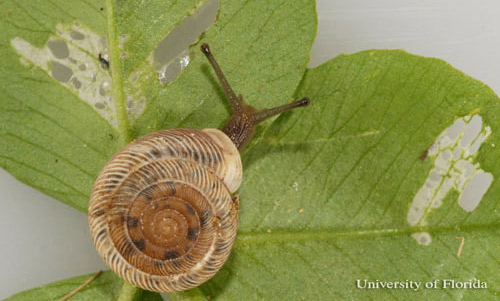Classification
Domain: Eukarya
Kingdom: Anamalia
Phylum: Mollusca
Class: Gastropoda
Order: Stylommatophora
Family: Polygyridae
Genus: Polygyra
Species: cereolus
Scientific name: Polygyra cereolus (Muhlfield, 1816)
Common name: Southern Flatcoil
Domain Eukarya: classified as organisms whose cells contain
membrane bound nuclei (Hickman et al. 2011).
Kingdom Anamalia: classified as multicellular organisms that are
predominantly heterotrophic, some are parasitic (Hickman et al.
2011).
Phylum Mollusca: meaning "soft body" in latin, mollusks are
characteristic of having their body divided into a head-foot section
and a visceral mass section (Hickman et al, 2011). Some synapmorphies shared by this Phylum include a radula, mantle, mantle
cavity, shell, muscular foot and open circulatory systems (except
those found in Class Cephalopoda)
(Hickman et al, 2011).
Class Gastropoda: meaning "stomach foot" in latin, gastropods
consist of slow-moving or sedentary animals that have an
asymmetrical visceral mass due to the process of torsion
(Hickman et al, 2011). Terrestrial gastropods develop directly, while
marine and freshwater species develop indirectly through a trochophore and a veliger larval stage (Hickman et al, 2011). There
are approximately 70,000 living species of gastropods and another
15,000 fossil species known (Hickman et al, 2011).
Family Polygyridae: As stated by Kathryn Perez of the University
of Alabama in her 2004 Centenary Research Grant Report, this family
of land snails is native to North America, with a large diversity
amongst their habitats, size and shape of their shells. Polygyrids
can be approximately 5-32 mm in diameter, and have shells many
shapes including subglobose, and discoidal (Perez, 2004).
Genus Polygyra: consist of snails with depressed to discoidal
shells that can be be both umbilicate or perforate (Pilsbry, 1940).
Polygyra have a continuous peristome and a raised parietal lamina
that connects the ends of the reflected lip (Pilsbry, 1940).
Reproductive distinctions include a penis with a simple wall and
lack of a sheath, no papilla or verge, and a short, slender spermathecal duct (Pilsbry, 1940). A ribbed jaw and the central and
lateral teeth of the radula with ectocones on them is also
characteristic of this genus (Pilsbry, 1940).
Species cereolus: This species has a very long lung, a moderately long kidney, an elongated, slender vagina and moderately convoluted hermaphrodite duct (Pilsbry, 1940). The shell is discoidal and varies from white to wood brown or fawn with gray or pale brown spots or radial streaks on the base(Pilsbry, 1940). P. cereolus also has a umbilicus with a comparatively small central cavity, and internal lamina (Pilsbry, 1940).


